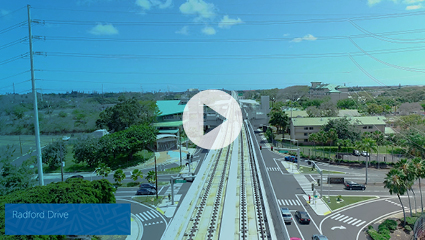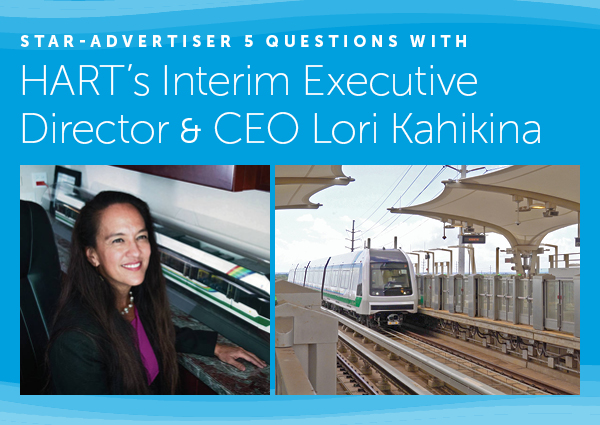HART’s Interim Executive Director & CEO Lori Kahikina was recently interviewed by the Honolulu Star-Advertiser to discuss the challenges to get the system back on track and completed to Ala Moana Center. Those questions and answers included:
What kind of waste and unjustified billing have you identified in the project?
We are restructuring HART to be more efficient by eliminating redundant positions and procedures, and evaluating the effectiveness of initiatives and processes.
Examples include:
1) Conversion of consultants to city staff. Some consultants are essential as certain skills are not found in Hawaii but are expensive. Aside from base salaries, overhead costs are charged by consulting firms, which doubles costs to HART.
2) Some contracting methods were ineffective, including the City Center Utilities Relocation contract. It ballooned from $400 million to $650 million and, after two years, is only 7% complete. This contract is being canceled.
3) A process was identified where a contractor was paid to prepare documents, which were reviewed by another consultant, and then by HART. Reducing these types of inefficiencies will save money and increase productivity.
How do you answer those who say that rail should stop short of Ala Moana Center?
Stopping short of Ala Moana Center would present several challenges. The city signed a Full-Funding Grant Agreement (FFGA) with the Federal Transit Administration for the project’s federal funding. We are obligated under the FFGA to deliver a 20-mile elevated rail system with 21 stations to Ala Moana. If we breach that contract, additional funding will be in jeopardy and the city may be required to repay the federal funds already received.
While a large bus transfer center is located at Middle Street, it is not accessible to eastbound buses traveling on Kamehameha or Nimitz highways. Coupled with heavy congestion on King and Dillingham, it is an inefficient rail transfer point. Additionally, Dillingham is the heaviest volume corridor for public transportation on Oahu. Stopping the project at Middle Street would fail to meet the transportation needs of the Dillingham community.
Finally, the Ala Moana Center is the city’s largest bus transit center with important connections to University of Hawaii-Manoa and Waikiki. More than 1,500 daily bus trips serve that area compared to about 800 trips at Middle Street.
What is happening to the shift in alignment on Dillingham Boulevard?
There are numerous problems with utility relocations along Dillingham. We must find a more effective way of getting this work done.
The current design of the rail guideway is to traverse down the center of Dillingham, where major water, sewer and utility lines exist and need to be relocated. Additionally, there are two Hawaiian Electric 138kV power lines on either side of Dillingham, both of which would need to be moved underground.
An idea, explored two years ago, would shift the guideway from the center of Dillingham Boulevard to the mauka side. By doing this, several of the major underground utilities would not require relocation and only the mauka HECO 138 kV line would need to be placed underground. This measure would reduce costs and time.
This is not a “silver bullet,” as this mauka shift requires additional property acquisitions. We are working closely with the two largest impacted landowners, Kamehameha Schools and UH (University of Hawaii), as well as HECO and other utilities, for a plan to accomplish the work.
Besides the $70 million in COVID-19 relief funds, how can HART narrow the $3 billion funding gap?
There are five ways to narrow the funding gap:
1) Tighten our belt to reduce internal costs. Overall, this is a small portion of the shortfall, but will add to a much larger amount over the project’s life.
2) A portion of the shortfall is from pandemic-related reduced levels of general excise tax and transient accommodations tax funding. We believe that the rollout of the COVID-19 vaccine will enable the Hawaii economy to recover more expeditiously.
3) Look for more prudent and efficient ways to complete the project, such as the mauka shift on Dillingham to reduce project costs.
4) Identify and reduce risks to decrease future bid prices.
5) Search for additional funding opportunities. Hawaii’s congressional leaders, especially Sen. Brian Schatz, have been very supportive and influential with respect to HART’s funding.
You said you once opposed the project. What turned you around?
When I worked with Mayor Peter Carlisle, he asked his Cabinet to be rail champions. I asked, “Why should I, since I live on the Windward side and would likely never use rail?” He reminded me that the Pali, Kalanianaole and H3 were all federally funded, so I have benefitted from similar projects.
After I started working at Kapolei as the ENV director (city Environmental Services), I would see massive traffic jams in the morning while heading to work. I knew this was not fair and it decreased the quality of life for many families.
Rail will benefit those commuters and will revitalize communities along the 20-mile route — making them vibrant places for residents to live, work and play.
Please visit the original story from Honolulu Star-Advertiser.


